
|
Recent Results
|
Recent Results
| Annual Reports
| NewsLetters
| Interferometry School
| Technical Reports
|
 |
|
Recent scientific results from the IRAM observatories are issued on
this page when they are made available by the authors. Interested
readers are asked to contact the investigators for more details. Only
the home institute of the principal investigator is listed.
|
|
PR 1011/05

|
A disk of dust and water around a young high-mass star
F.F.S. van der Tak, C.M. Walmsley,
F. Herpin, C. Ceccarelli
Max-Planck-Institut für Radioastronomie,
Bonn, Germany
High-mass stars may form by disk accretion like low-mass stars, but
observational evidence for massive circumstellar disks remains sparse,
even after intense searches. New observations with the IRAM Plateau de
Bure interferometer of dust continuum (strong source in the upper left
diagram, the two weak sources are dominated by free-free emission) and
H218O line emission (upper right diagram) at 1.3
mm wavelength show a rotating disk around the nearby (distance = 1kpc)
high-mass (20,000 solar luminosity) protostar AFGL 2591, whose infrared
K-band image (Preibisch et al. 2003 (A&A 412, 735)) is shown in the
lower left.
The mass of the disk is 0.8 solar masses, or 5% of the mass of the
central star. The observations show that the dust grains in the disk
are unusually large, as a result of coagulation. The disk is seen in
an almost face-on orientation. The spectral line data show rotating
motions, and the rotation speed is as expected for a star of this
mass. The diagram on the lower right displays, in each velocity
channel, the offset of the H218O emission peak
from the phase center. Triangles indicate redshifted material, circles
correspond to the line center, and squares mark blueshifted gas. The
disk is very rich in water, because the ice mantles on the dust grains
have recently evaporated.
For more details see astro-ph/0510640 (A&A in press)
|
|
PR 1005/05

|
Continuum emission in NGC1068: Indications for a turnover in the core spectrum
M. Krips, A. Eckart, R. Neri, R. Schödel, S. Leon, D. Downes,
S. García-Burillo, F. Combes Harvard-Smithsonian Center for Astrophysics, SMA, Hawaii
The bright, nearby (D=14Mpc) active galaxy NGC1068 is
regarded to be the archetype for unification schemes of
Seyferts based on the directional obscuration of its
AGN. High angular resolution observations were recently
carried out at 3mm and 1mm with the IRAM PdBI using its A
configuration. Three continuum peaks are detected in
NGC1068, one centered on the core, one associated with the
jet and a third one with the counter-jet.
This is the first significant
detection of the large scale radio jet and
counter-jet at mm wavelengths in NGC1068. The central
emission peak located at the position of the radio core also
contains a significant fraction (~60%) of different jet
components detected within the central 2'' in higher angular
resolution radio maps (e.g., Gallimore et al. 2004). While
the fluxes of the (large scale) jet components agree with a
steep spectral index extrapolated from cm-wavelengths, the
core fluxes indicate a turnover of the inverted cm- into a
steep mm-spectrum at roughly 50GHz which is most likely
caused by electron-scattered synchrotron emission (ESSE) in
the obscured central region of NGC1068.
For more details, see astro-ph/0509825 (A&A in press)
|
|
PR 0128/05

|
Molecular gas observation of a triply lensed galaxy typical of the Cosmic Far-Infrared Background
J-P. Kneib, R. Neri, I. Smail, A. Blain, K. Sheth, P. van der Werf, K. Knudsen
OAMP, Laboratoire d'Astronomie de Marseille, France
The submm galaxy SMMJ16359+6612 at z~2.5 is strongly lensed
by the massive cluster Abell 2218. The lens produces three
images of this intrinsically faint (~0.8mJy at 850um)
galaxy. The large total magnification factor of 45 provides
a rare opportunity to probe in detail the nature of a
distant galaxy, part of the population which produces the
bulk of the submm cosmic far-infrared background.
Sensitive D-configuration observations have been made with
the Plateau de Bure interferometer to map in detail the
CO(3-2) emission line. The data show an outstanding
double-peak velocity profile. By constraining these
observations with Hubble Space Telescope imaging and Keck
infrared spectroscopy data, we identify the two velocity
peaks with two spatially distinct components. We conclude
that this source is likely to be a compact merger of 2
fairly typical star-forming galaxies with a maximal
separation between the two nuclei of ~3kpc. This system is
much less luminous and massive than other high-z submm
galaxies studied to date, but it bears a close similarity to
similarly luminous, dusty starburst resulting from
lower-mass mergers in the local Universe.
For more details, see
Astronomy & Astrophysics, 434, 819, 2005
|
|
PR 1110/04

|
Q0957+561 revised: CO emission from a disk at z=1.4
M. Krips, R. Neri, A. Eckart, D. Downes,
J. Martin-Pintado, P. Planesas
University of Cologne, Germany
Q0957+561 at a redshift of z=1.4141, is the first detected
gravitationally lensed quasar (Walsh et al. 1979). New IRAM
PdBI observations of this system confirm a previous
detection of the CO(2-1) line emission by Planesas et
al. (1999) towards the southern lensed image B and
substantiate a double peaked line profile towards the
northern component A.
Our new interferometric CO maps of the host galaxy agree
well with HST images and we thus argue that the two velocity
components seen at image A arise from molecular gas in the
disk of the host galaxy. This hypothesis is also supported
by detailed simulations of the gravitational lens effect in
Q0957+561 explaining also the absence of the redshifted line
towards the lensed image B. While the blueshifted part of
the gas emission is located closer to the lens in the
projected lens plane and thus deeper in the lens potential
so that it is deflected into several images, the redshifted
part is associated with a region at a larger distance from
the lens where the gravitational potential can only produce
a single magnified image. The gas mass of the disk is
estimated to 5x1010 sun masses.
For more details, see
Astronomy & Astrophysics, 431, 879, 2005
|
|
PR 0923/04

|
A compact starburst core in the dusty Lyman break galaxy Westphal-MD11
A.J. Baker, L.J. Tacconi, R.
Genzel, D. Lutz, M.D. Lehnert MPE
Garching, Germany
Westphal-MD11 is an unusually dusty z = 2.98 Lyman break galaxy:
despite the fact that it is unlensed, its observed 850 micron flux
density (5.5 mJy) is comparable to that of the highly magnified
system MS1512-cB58 (4.2 mJy). New, extremely deep observations
with the PdBI prove that this similarity does not extend to the
two systems' molecular line emission. After 42 hours of
integration, CO(3-2) emission from WMD11 is not detected (right
panel: 3 sigma upper limit 0.11 Jy km/s), in stark contrast to the
previously published detection of cB58 (left panel: 5.5 sigma peak
0.37 Jy km/s). Contours in both panels are multiples of 1 sigma
after integration over the full (assumed) line widths.
WMD11 can only achieve its very high ratio of dust to molecular
gas luminosity if its dust emission arises from a spatially
compact structure radiating near its blackbody limit- similar to
the central disks seen in local ULIRGs. Since WMD11 shows a
merger morphology in optical imaging, such a configuration is not
implausible. An intense, centrally concentrated starburst fuelled
by a relatively modest molecular gas reservoir is quite different
from what is observed in cB58, underlining the diversity of
star-forming systems that are selected by the Lyman break
technique.
For more details, see
Astrophysical Journal, 613, L113, 2004
|
|
PR 0329/04
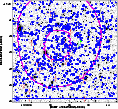
|
MAMBO observations of a z=4.1 proto-cluster
C. De Breuck, F. Bertoldi, C. Carilli,
A. Omont, B. Venemans, H. Rottgering, R. Overzier, M. Reuland, G. Miley, R. Ivison,
W. van Breugel European Southern Observatory, Garching,
Germany
The z=4.1 radio galaxy TN J1338-1942 is surrounded by a
proto-cluster of Ly-alpha emitters and Lyman break galaxies. We
have obtained a 1.2mm map of this field using MAMBO at the IRAM
30m (shown as blue S/N contours in the figure).
We detect up to ten mm sources, which represents an overdensity
of a factor three compared to blank field MAMBO surveys. Using
a deep VLA 1.4 GHz map, we can identify at least half of these
faint MAMBO sources in our deep VLT optical images. Very deep
optical VLT spectroscopy did not yield redshifts, so
alternative redshift determination techniques (e.g. CO
spectroscopy) will be needed to determine if these sources are
indeed members of this distant proto-cluster. If confirmed,
this would reveal a population of dust-obscured galaxies with
extremely high star-formation rates, which cannot be identified
using optical selection techniques.
For more details,
see Astronomy &
Astrophysics, 424, 1, 2004 |
|
PR 0329/04
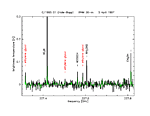
|
Ethylene glycol in comet C/1995 O1 (Hale-Bopp)
J. Crovisier, D. Bockelée-Morvan, N. Biver, P. Colom, D. Despois,
D.C. Lis Observatoire de Paris, Meudon,
France
We report the detection of ethylene glycol (HOCH2CH2OH)
in comet C/1995 O1 (Hale-Bopp) from the analysis of archival radio spectra.
About ten rotational lines of the molecule are observed in spectra obtained
at the IRAM 30-m telescope and Plateau de Bure interferometer and at the
Caltech Submillimeter Observatory, in spring 1997. The identification
was made just after the rotational lines of this molecule was included
in the Cologne Database for Molecular Spectroscopy. The production rate
of ethylene glycol is approximately 0.25% that of water, making it one
of the most abundant organic molecules in cometary ices. This detection
strengthens the similarity between interstellar and cometary material.
It outlines the possible role of cometary impacts in the origin of life
by seeding the early Earth with prebiotic molecules.
For more details,
see Astronomy &
Astrophysics, 418, L35, 2004 |
|
PR 0326/04
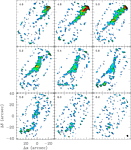
|
Molecular hydrogen as baryonic dark matter
A. Heithausen,
Radioastronomisches Institut, Universität Bonn, Germany
Unravelling the nature of dark matter is one of the biggest challenges of
modern astronomy. An interesting candidate is molecular hydrogen. Because
at most temperatures in the interstellar medium it cannot be observed directly,
it can be only traced through secondary tracers such as carbon monoxide,
CO. Pfenniger & Combes have proposed that most of the dark matter in the
outskirts of our Milky Way could be in form of cold molecular gas with a
fractal structure. Basic building blocks in their model are so-called clumpuscules
with sizes of about 100AU and the mass of Jupiter (1/1000 of the mass of
the sun).
High-angular resolution CO observations obtained with the Plateau
de Bure Interferometer reveal now that such small structures indeed exist.
Feature-less structures seen in single-dish measurements break up into several
smaller clumps in the interferometer map (see Figure). At an adopted distance
of 100pc their sizes are of order a few hundred AU, some of which are still
unresolved at an angular resolution of about 3''. The clumps have a fractal
structure with a fractal index between 1.7 and 2.0. Their kinetic temperature
is between 7K and 18K. Adopting standard conversion factors masses are
about 1/10 of a Jupiter mass for individual clumps and densities are higher
than 20000cm3. These structures are so small that it is only possible to
detect them with highest angular resolution and sensitivity.
For more details, see 2004,
Astrophysical Journal Letters, 606, L13, 2004
|
PR 1112/03
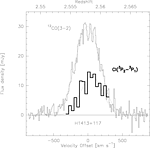 |
Atomic Carbon in the Cloverleaf Quasar at z=2.5
A. Weiss, C. Henkel,
D. Downes, F. Walter
Instituto de
Radioastronomia Milimétrica, Spain
We observed the upper fine structure line of neutral carbon (νrest =
809GHz), the CO(3-2) line (νrest = 345GHz) and
the 1.2mm continuum emission from H1413+117 (Cloverleaf quasar,
z=2.5) using the IRAM interferometer.
Together with the detection of the lower fine structure line
(Barvainis et al 1997), the Cloverleaf quasar is now only the
second extragalactic system, besides M82, where both carbon lines
have convincingly been detected. Our analysis shows that the
carbon lines are optically thin and have an excitation temperature
of Tex= 30K. CO is subthermally excited and the
observed line luminosity ratios are consistent with
n(H2)~ 103-4 cm-3 at
Tkin= 30-50 K. Using three independent methods (CI, dust,
CO) we derive a total molecular gas mass (corrected for
magnification) M(H2)~1.2 +/- 0.3 x 1010 solar
masses. Our observations suggest that the molecular disk extends
beyond the region seen in CO(7-6) to a zone of more moderately
excited molecular gas that dominates the global emission in CI,
and the low J CO lines.
For more details, see Astronomy & Astrophysics, 409, L41, 2003 |
PR 1017/03
 |
Powerful CO Emission from Three
Submillimeter Galaxies at z=2.4, 2.5 and 3.4
R. Neri, R. Genzel,
R.J. Ivison, F. Bertoldi, A.W. Blain, S.C. Chapman, P. Cox, T.R. Greve,
A. Omont, D.T. Frayer Institut de
Radio Astronomie Millimétrique, France
During the last years significant progress has been made with
SCUBA at 850μm and MAMBO at 1.2mm to resolve a significant
fraction of the background into a population of faint
submillimeter sources. We have now been able to determine accurate
redshifts with the Plateau de Bure interferometer and map the
molecular CO emission in three of these sources: SMMJ04431+0210,
SMMJ09431+4700 and SMMJ16368+4057. Today, these three galaxies
more than double the number of millimeter-confirmed SCUBA
redshifts.
Figure 1 shows (top) the
velocity-integrated naturally-weighted CO maps superposed on
optical K (left and right) and I band images, and (bottom) the
corresponding spectra with the LSR velocity scaled centered on the
CO redshift. Our moderate resolution interferometric observations
not only confirm the redshifts identified from rest-frame
UV/optical spectroscopy but also reveal that at least some SCUBA
galaxies are luminous and gas-rich massive starburst/AGN systems
seen at a similar epoch to the UV-bright QSO and Ly-break galaxies
populations. As such, the submillimeter population of SCUBA
selected galaxies is a crucial key for studying the high-z
assembly of mass at the tip of the galaxy luminosity function and
a critical test for current galaxy formation scenarios.
For more details, see Astrophysical Journal Letters, 597, L113, 2003 |
PR 1016/03
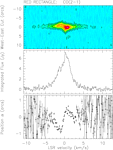 |
A Keplerian Disk in the Red Rectangle?
V. Bujarrabal, R. Neri,
J. Alcolea, C. Kahane Observatorio
Astronomico Nacional, Spain
The Red Rectangle is a nearby (~400pc) low-mass proto-planetary
nebula with an eye-catching reddish bipolar structure in visible
light. From different grounds it had been proposed that most of
the nebular gas surrounding the Red Rectangle is not escaping from
the central star, but lying on a gravitationally bound disk. The
detection and so the formation of disks around post-AGB stars
could lead to a significant upturn in the understanding of
proto-planetary evolution.
We observed molecular CO emission from the Red Rectangle with the
IRAM PdBI in the CD set of configurations. Our high-resolution
maps (3.6''x1.6'' at 230 GHz) show that the bulk of the CO(2-1)
emission is found to arise from a thin disk in the equatorial
regions of the Red Rectangle. This flattened region measures 2000
AU (full extent) and is less than 500 AU thick. The gas mass
contained in the disk is estimated to about 0.04 solar masses, and
the gas velocity increases towards the center with a pattern very
much consistent with Keplerian rotation. Figure 1 summarizes
these results: (top) position velocity cut in the East-West
direction, (middle) spectral profile and (bottom) emission
centroids. These observations provide first evidence for the
existence of an orbiting molecular disk around the central star of
a post-AGB star.
For more details, see Astronomy
& Astrophysics, 409, 573, 2003
|
PR 0528/03
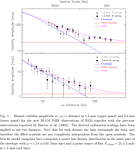 |
Subarcsecond Millimeter-wave Observations of the Protostellar Collapse
Candidate B335: Detection of a Disk and Implications for Envelope Structure
D.W.A. Harvey, D.J. Wilner, P.C. Myers, M. Tafalla, D. Mardones
Harvard-Smithsonian Center for Astrophysics, Cambridge, USA
The dense core in the B335 dark globule is generally recognized as
the best protostellar collapse candidate. This dense core is
nearby (250 pc), isolated, and nearly spherical. It contains a
deeply embedded low luminosity young stellar object (3 solar
luminosities) discovered at far-infrared wavelengths and detected
by IRAS only at λ≥60μm.
We observed dust continuum from B335 at subarcsecond resolution
with the IRAM PdBI at wavelengths of 1.2 and 3.0 mm. The
observations probe to < 100 AU size scales and reveal a compact
source component that we identify with a circumstellar disk. We
analyze the data in concert with previous lower resolution PdBI
observations and find a best fit density structure for B335 that
consists of a power law envelope with index p=1.55 ±
0.04 (r  5000 AU) together with a compact source (FWHM ~ 45
AU) with flux F1.2 21 ±2 mJy. We estimate
a systematic uncertainty in the power law index Δ p 5000 AU) together with a compact source (FWHM ~ 45
AU) with flux F1.2 21 ±2 mJy. We estimate
a systematic uncertainty in the power law index Δ p
 0.15,
where the largest error comes from the assumed form of the dust
temperature falloff with radius. This determination of the inner
density structure of B335 has a precision unique amongst
protostellar cores, and it is consistent with the
r-1.5 profile of gravitational free-fall, in
accord with basic expectations for the formation of a star. The
flux (and implied mass) of the compact component in B335 is
typical of the disks around T Tauri stars. 0.15,
where the largest error comes from the assumed form of the dust
temperature falloff with radius. This determination of the inner
density structure of B335 has a precision unique amongst
protostellar cores, and it is consistent with the
r-1.5 profile of gravitational free-fall, in
accord with basic expectations for the formation of a star. The
flux (and implied mass) of the compact component in B335 is
typical of the disks around T Tauri stars. |
PR 0122/03
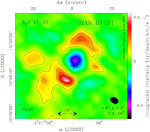 |
Disappearance of N2H+ from the gas phase in the Class 0
protostar IRAM 04191?
A. Belloche, P. André
Laboratoire de Radioastronomie, ENS,
and Service d'Astrophysique, CEA/Saclay, France
IRAM 04191+1522 was discovered a few years ago in the 1.3mm dust
continuum with MAMBO on the IRAM 30m telescope (André
et al. 1999). With an estimated age of ~1-3x
104 yr since the beginning of the accretion phase, it
is currently the youngest Class 0 protostar known in the Taurus
molecular cloud. It is associated with a powerful bipolar outflow
and a prominent infalling envelope also undergoing fast,
differential rotation (Belloche
et al. 2002).
A new map of this object was
obtained in N2H+(1-0) with the Plateau de
Bure interferometer. This integrated intensity map reveals a hole
of N2H+ emission (blue color) in the inner
protostellar envelope whose central position is marked by the
black cross, as traced by the centroid of the 1.3mm continuum
emission measured with PdBI. Two N2H+ peaks
(red color) are observed on either side of the central position,
approximately along the direction perpendicular to the outflow
axis. A preliminary combination of these PdBI data with short
spacings obtained at the 30m telescope is shown in Figure 2. These results
suggest that N2H+ disappears from the gas
phase above a density of ~106 cm-3.
For more details, see Astronomy
& Astrophysics, 419, L35, 2004
|
PR 0120/03
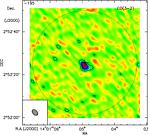 |
Molecular gas and dust at z=2.6 in SMM J14011+0252
D. Downes, P. Solomon
IRAM, France
We used the IRAM Interferometer to detect CO(3-2), CO(7-6), and 1.3 mm
dust continuum emission from the submillimeter galaxy SMM
J14011+0252 at a redshift of 2.6.
Contrary to a recent claim that the CO was extended over 6.6'' (57
kpc), the new data yield a size of 2'' x 0.5'' for the CO and the
dust. Although previous results placed the CO peak in a region
with no visible counterpart, the new maps show the CO and dust are
centered on the J1 complex seen on K-band and optical images. We
suggest the CO is gravitationally lensed not only by the
foreground cluster A1835, but also by an individual galaxy on the
line of sight. Comparison of measured and intrinsic CO brightness
temperatures indicates the CO size is magnified by a factor of 25
+/- 5. After correcting for lensing, we derive a true CO diameter
of ~0.08'' (700 pc), consistent with a compact circumnuclear disk
of warm molecular gas similar to that in Arp 220. The high
magnification means the true size, far-IR luminosity, star
formation rate, CO luminosity, and molecular gas mass are all
comparable with those in present-epoch ultraluminous IR galaxies,
not with those of a huge, massive, early-universe galactic
disk.
For more details, see Astrophysical Journal, 582, 37, 2003
|
PR 1129/02
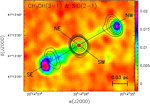 |
The disk/jet system in the high-mass (proto)star IRAS20126+4104
R. Cesaroni, R. Neri, L. Olmi,
L. Testi, C.M. Walmsley, P. Hofner
Oss.Astr.Arcetri, Italy
Newly born high-mass stars are thought to be surrounded by
circumstellar disks as much as less massive, solar type
stars. Close to the star, part of the infall is likely to be
reversed into outflow, powering collimated molecular jets. An
example of this is the luminous source IRAS20126+4104.
The lefthand figure represents a composite map of this object
obtained with the Plateau de Bure interferometer. This shows the
SiO(2-1) (colour image, resolution 1.8''x1.6'') and
CH3OH(2-1) (contours, resolution 2.7''x2.6'') line
emission, which clearly demonstrates the presence of a compact
molecular core where the source (red star) is embedded and the
existence of a bipolar jet aligned in the SE-NW direction. The velocity-position plots
of the line emission in various tracers along the SE-NW and NE-SW
directions indicated by the lines drawn in the lefthand figure
reveal kinematical details. In particular the SE-NW cut shows the
presence of a velocity gradient in the SiO(2-1) (colour image) and
CH3OH(2-1) (contours) lines, whereas the NE-SW cut
demonstrates the existence of a velocity gradient perpendicular to
the jet and hence likely associated with a circumstellar disk: in
this picture the contours and colour image refer respectively to
the CH3OH(2-1) and CH3CN(12-11) line
emission.
|
PR 1022/02
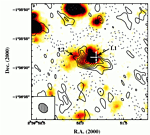 |
A Very Massive Submillimeter Galaxy at z = 2.8
R. Genzel, A.J. Baker, L.J. Tacconi, D. Lutz, P. Cox
S. Guilloteau, A. Omont
MPE Garching, Germany
SMMJ02399-0136 is a z=2.808 submillimeter-bright galaxy first
detected in the 850 micron SCUBA Cluster Lens Survey. Its
rest-frame UV morphology shows two peaks (L1 and L2 in the Keck
R-band image at left), one of which coincides with a bright X-ray
source (white cross). New 1.2mm continuum observations with the
PdBI (contours) have resolved the galaxy's dust emission for the
first time; they reveal an east-west elongation consistent with
the predicted lensing shear, and a centroid which agrees with the
rest-UV/X-ray peak L1. CO(3-2) line emission from the source is
also spatially resolved, and shows a double-horned global spectrum which is the
classical signature of rotation. On the basis of its dust
morphology and gas dynamics, SMMJ02399-0136 appears to contain a
massive molecular ring/disk which rotates about a buried type 2
QSO. Its dynamical mass of >3.1011 solar masses within
a radius of 8 kpc is surprisingly large relative to the
predictions of CDM hierarchical structure formation models, in
which the most massive systems tend to be formed by merging at
lower redshifts. A quantitative
comparison with these models shows that they may
underpredict the comoving number densities of massive baryonic
systems at z~3 by significant factors.
For more details, see Astrophysical Journal, 584, 633, 2003.
|
PR 1010/02
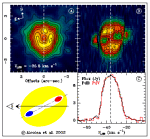 |
Mapping the circumstellar envelope around HD 161769
J. Alcolea, R. Neri,
V. Bujarrabal, A. Castro-Carrizo
Observatorio Astronomico Nacional, Spain
CO J=2-1 observations with a spatial resolution of ~1'' of
the circumstellar envelope around the white-yellow giant HD 161769
have unveiled the structure and kinematics of this nebula, very
probably a young progenitor of a bipolar planetary nebula.
When a star like our Sun becomes very old, it gets redder and
starts loosing mass at an increasing rate, forming a thick spherical
cocoon of gas and dust, which expands into space at a velocity of a
few km/s. At the end of this stage (known as the AGB phase) the mass
loss is so copious, up to 0.0001 solar masses per year, that the star
can not endure this loose of weight for too long. Finaly, after some
1000 yr, it initiates the last journey in its evolution before it
dies: the heavy mass loss stops and the star becomes hotter and
hotter. This transition is very fast, and hence just a few rare
objects in the galaxy that are at this point in their evolution:
HD 161769 (also known as IRAS 17436+5003 and V814 Her) is one of
these.
As the last layers of dust and gas move away, a cavity forms
around the star. This hole can be seen in panel A, where we
show the map of the emission at the systemic velocity (marked with a
dashed line in panels B and C). Simultaneously, a much lighter but
faster collimated flow ignites, excavating a tunnel in the nebula
along two opposite directions, and breaking its former spherical
symmetry. These two cavities are seen in panel B as two
point-symmetric minima in the position vs. velocity diagram for a
cut along the symmetry axis of the nebula (the dashed line in panel
A). CO emission at velocities larger than the formerly expansion
velocity, the wings in the spectrum in panel C, also arise at this
point. This fast molecular gas might have been accelerated by the
passage of the fast flow (yet unseen). We also plot a sketch of the
nebula, showing the slowly expanding gas (in yellow), the two
excavated cavities and central hole (in white), and the approaching
and receding fast molecular gas (in blue and red respectively). We
also indicate the orientation of the symmetry axis of the nebula
(dotted line) with respect to the line of sight (arrow).
|
PR 1009/02
 |
CO emission in a z=3.1 radio galaxy
C. De Breuck, R. Neri, R. Morganti, A. Omont, B. Rocca-Volmerange, D. Stern, M. Reuland, W. van Breugel, H. Rottgering, S.A. Stanford, H. Spinrad, M. Vigotti, M. Wright
Institut d'Astrophysique de Paris, France
B3 J2330+3927 is a z=3.087 radio galaxy with bright sub-mm
dust emission. The redshifted CO(4-3) emission was detected at the
10sigma level in 27 hours of integration with the Plateau de Bure
Interferometer (blue contours, resolution 3.2" x 2.3" at
PA=56). This emission coincides with the brightest component in a
Keck K-band image (orange), which may pinpoint the position of the
AGN inside the host galaxy.
The line emission is approximately 500 km/s wide in the 3mm spectrum, and is remarkably
close in velocity space to an associated neutral Hydrogen absorber
as seen in the Ly-alpha profile determined from optical
spectroscopy. This suggests that the CO and neutral Hydrogen
originate from the same gas cloud surrounding this massive
galaxy. The mass implied from the CO emission is 100 to 1000 times
higher than the estimates determined from the Ly-alpha data.
For more details, see Astronomy & Astrophysics, 401, 911, 2003
|
PR 0916/02
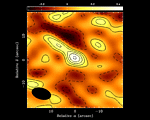 |
CO line emission from a Lyman break galaxy
A.J. Baker,
L.J. Tacconi, R. Genzel, M.D. Lehnert, D. Lutz
MPE Garching, Germany
MS1512+36-cB58 is a z = 2.72 Lyman break galaxy which undergoes a
factor of ~30 gravitational magnification by a z = 0.37 foreground
galaxy cluster. As a result, it is the optically brightest
representative of an important population of low-metallicity,
high-redshift, star-forming systems. Previous studies at other
facilities had failed to detect molecular line emission from cB58.
After 32 hours of PdBI observations, however, the galaxy's CO(3-2)
line was successfully detected at the 5 sigma level in the
integrated map (contours are multiples of 1 sigma = 0.085 Jy/beam
km/s, for a synthesized beam of 8.2"x4.8").
From the integrated line intensity, it appears that cB58 contains
enough molecular gas to fuel ongoing star formation at the current
rate for the next few hundred million years. From the line width
(channels are 48 km/s wide in the spectrum),
cB58's gas mass fraction is estimated to lie in the range of 10-50%.
For more details, see Astrophysical
Journal, 604, 125, 2004
|
PR 0628/02
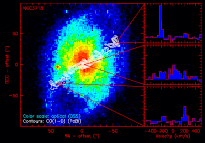 |
Molecular gas in the warped galaxy NGC3718
M. Krips,
A. Eckart, S. Leon, J.-U. Pott
University of Cologne, Germany, and the
NUGA team
The warped galaxy NGC3718 belongs to the sources studied in the
NUGA project (NUclei of GAlaxies). This is an
international collaboration that aims at determing the distribution
and dynamics of molecular gas in the innermost (~1kpc) region of the
nuclei of active galaxies with the highest available spatial
resolution to study systematically the different mechanism of gas
fueling into AGNs. NGC3718 is not only known for its strongly
warped gas disk (simulations are in progress (Pott et al.)) but it
also has an impressive dust lane crossing the edge-on disk.
To get a more detailed and complete picture of this galaxy high
resolution mosaic observations (beam: 5.8"x3.2"@37; 7 fields mosaic)
with the Plateau de Bure Interferometer were carried out at the end
of last and the beginning of this year. CO was detected in the
innermost region and in the outer parts of the galaxy. The molecular
gas content is found to be typical of an elliptical galaxy with a
relatively low molecular gas mass. Compared to the Milky Way it is
rather a small galaxy (~ half of the size of the Milky Way). The
image in the figure shows line and continuum emission and was
deconvolved with a bigger beam for representation purposes.
|
PR 0626/02
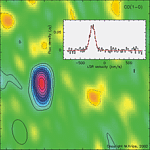 |
CO mapped in a nearby low-declination QSO
M. Krips,
T. Bertram, C. Straubmeier, A. Eckart & J. Staguhn,
University of Cologne, Germany
The QSO was taken from the
COLOGNE NEARBY QSO SAMPLE. This sample is formed by a
set of closest QSOs for which detailed studies of the molecular gas
distribution and kinematics can be performed on sub-kpc scales. In
combination with additional data taken at other wavelengths, a very
detailed picture can be given of the properties of these nearby QSO
host galaxies allowing furthermore to draw conclusions for highly
redshifted QSO host data.
The high resolution (beam: 3.3"x1.9"@-166) observations with the PdB
Interferometer have revealed molecular line emission from the QSO
(used configuration: BC; integration time: a few hours). The source
appears to be aligned north-south with an extension in the line
emission of roughly the size of the central bulge in our Milky Way
(~4-5kpc). The CO line implies a low total gas mass of roughly a
fourth of the one obtained for the Milky Way.
|
